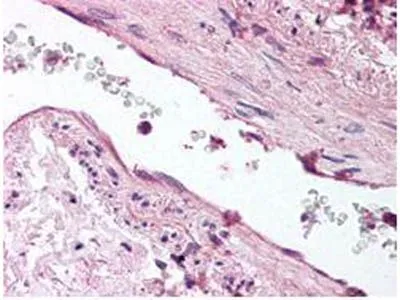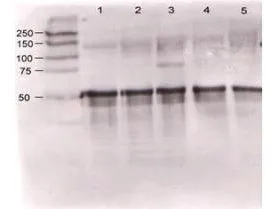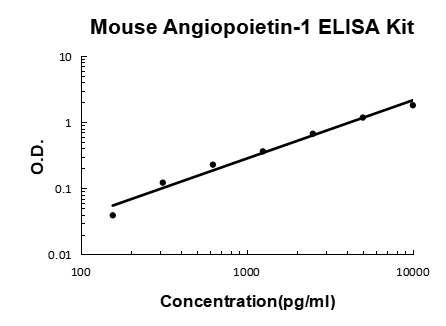
IHC-P of ANG1 antibody was diluted 1:500 to detect ANG1 in human lung tissue. The image shows the localization of antibody as the precipitated red signal, with a hematoxylin purple nuclear counter stain.
Angiopoietin 1 antibody
GTX28451
ApplicationsImmunoFluorescence, ImmunoPrecipitation, Western Blot, ELISA, ImmunoCytoChemistry, ImmunoHistoChemistry, ImmunoHistoChemistry Paraffin
Product group Antibodies
TargetAngpt1
Overview
- SupplierGeneTex
- Product NameAngiopoietin 1 antibody
- Delivery Days Customer9
- Application Supplier NoteWB: 1:500-1:2000. IHC-P: 1:200-1:800. ELISA: 1:5000-1:25000. *Optimal dilutions/concentrations should be determined by the researcher.Not tested in other applications.
- ApplicationsImmunoFluorescence, ImmunoPrecipitation, Western Blot, ELISA, ImmunoCytoChemistry, ImmunoHistoChemistry, ImmunoHistoChemistry Paraffin
- CertificationResearch Use Only
- ClonalityPolyclonal
- Concentration80 mg/ml
- ConjugateUnconjugated
- Gene ID11600
- Target nameAngpt1
- Target descriptionangiopoietin 1
- Target synonyms1110046O21Rik; an; Ang; Ang1; Ang-1; angiopoietin-1
- HostRabbit
- IsotypeIgG
- Protein IDO08538
- Protein NameAngiopoietin-1
- Scientific DescriptionAngiopoeitin-1 (Ang-1) and Antiopoietin-2 (Ang2) are important for development of the endothelium, by regulating tyrosine phosphorylation of the membrane receptor Tie-2/Tek. Ang-1 binding to Tie-2/Tek causes phosphorylation of the receptor. Ang-2 competes for this binding, and thus blocks receptor phosphorylation. Ang-1 has potential fibrinogen-like domain at the carboxy terminus and coiled-coil regions in the amino terminus. Ang-1 is prominently expressed in the myocardium of atrium and ventricle, mesenchymal and smooth muscle cells surrounding most blood vessels, and lung. In the adult, ANG-1 is also expressed in the heart and liver. To our knowledge, this is the first time that an Ang antibody recognizes a band above 55 kD. This antibody (and the ang-2 antibody, GT28452) give a band at 75 kD which resembles the original size, because these are soluble highly glycosylated proteins, which should run higher that the calculated molecular weight of 55 kD.
- Storage Instruction-20°C or -80°C,2°C to 8°C
- UNSPSC12352203
References
- Inhibition of microRNA-711 limits angiopoietin-1 and Akt changes, tissue damage, and motor dysfunction after contusive spinal cord injury in mice. Sabirzhanov B et al., 2019 Nov 4, Cell Death DisRead more
- Angiopoietin 1 influences ischemic reperfusion renal injury via modulating endothelium survival and regeneration. Chiang WC et al., 2019 Feb 13, Mol MedRead more
- MicroRNA-711-Induced Downregulation of Angiopoietin-1 Mediates Neuronal Cell Death. Sabirzhanov B et al., 2018 Oct 15, J NeurotraumaRead more






